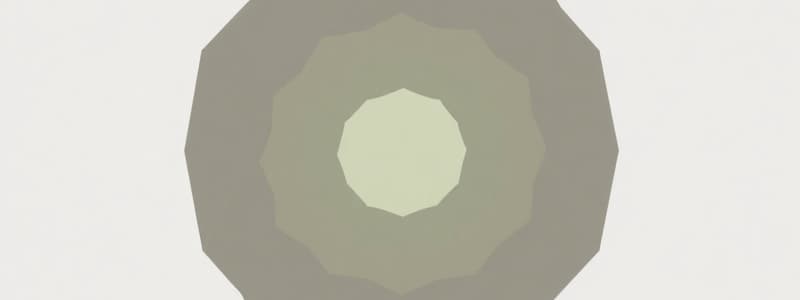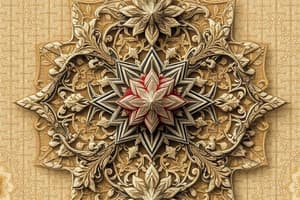Podcast
Questions and Answers
Given the image of a shape on a grid, which transformation would result in a shape that overlaps the original?
Given the image of a shape on a grid, which transformation would result in a shape that overlaps the original?
- Horizontal stretch by a factor of 2.
- Reflection across a diagonal axis through its center. (correct)
- Rotation of 45 degrees clockwise around its center.
- Vertical compression to half its original height.
By observing the grid, what would be the predicted outcome if the colored area of the grid was rotated 180° around its central point?
By observing the grid, what would be the predicted outcome if the colored area of the grid was rotated 180° around its central point?
- The shape would appear shifted but its orientation will remain the same.
- The shape would remain unchanged.
- The shape would be inverted but its position will remain the same. (correct)
- The shape would be reduced in size by half.
A scaled copy of the shape is created such that its area is 4 times larger. What is the side length of the new shape compared to the original?
A scaled copy of the shape is created such that its area is 4 times larger. What is the side length of the new shape compared to the original?
- The side length remains the same.
- The side length is doubled. (correct)
- The side length is quadrupled.
- The side length is halved.
Imagine the colored shape from the grid is part of a larger image. If the entire image is scaled down to 50% of its original size, how would the perimeter of the colored shape change?
Imagine the colored shape from the grid is part of a larger image. If the entire image is scaled down to 50% of its original size, how would the perimeter of the colored shape change?
The colored shape is translated such that its center moves from coordinate (3,4) to (7,8). What translation vector represents this movement?
The colored shape is translated such that its center moves from coordinate (3,4) to (7,8). What translation vector represents this movement?
If the grid is transformed by a shear transformation parallel to the x-axis with a shear factor of 0.5, how would the shape change?
If the grid is transformed by a shear transformation parallel to the x-axis with a shear factor of 0.5, how would the shape change?
If the colored shape is reflected across a vertical line passing through the center of the grid, how does its position change?
If the colored shape is reflected across a vertical line passing through the center of the grid, how does its position change?
Imagine the grid coordinates are doubled in both the x and y directions. How will the area of the colored shape change?
Imagine the grid coordinates are doubled in both the x and y directions. How will the area of the colored shape change?
Consider the colored area to be a symmetrical object. What is the minimum angle of rotation, around its center, that would make the object appear unchanged?
Consider the colored area to be a symmetrical object. What is the minimum angle of rotation, around its center, that would make the object appear unchanged?
Suppose each square in the grid has a side length of 1 unit. If the shape is dilated by a factor of 3 with the center of dilation at the origin, what would be the difference in the perimeter of the original shape and the dilated shape?
Suppose each square in the grid has a side length of 1 unit. If the shape is dilated by a factor of 3 with the center of dilation at the origin, what would be the difference in the perimeter of the original shape and the dilated shape?
Flashcards
What is symmetry?
What is symmetry?
An area that appears to be symmetrical around a central point or line. This means that if you were to fold the shape in half, both halves would match perfectly.
Study Notes
- The image shows a shape on a grid.
- The grid appears to be 7 by 7. The green shape covers 9 grid points.
Studying That Suits You
Use AI to generate personalized quizzes and flashcards to suit your learning preferences.




